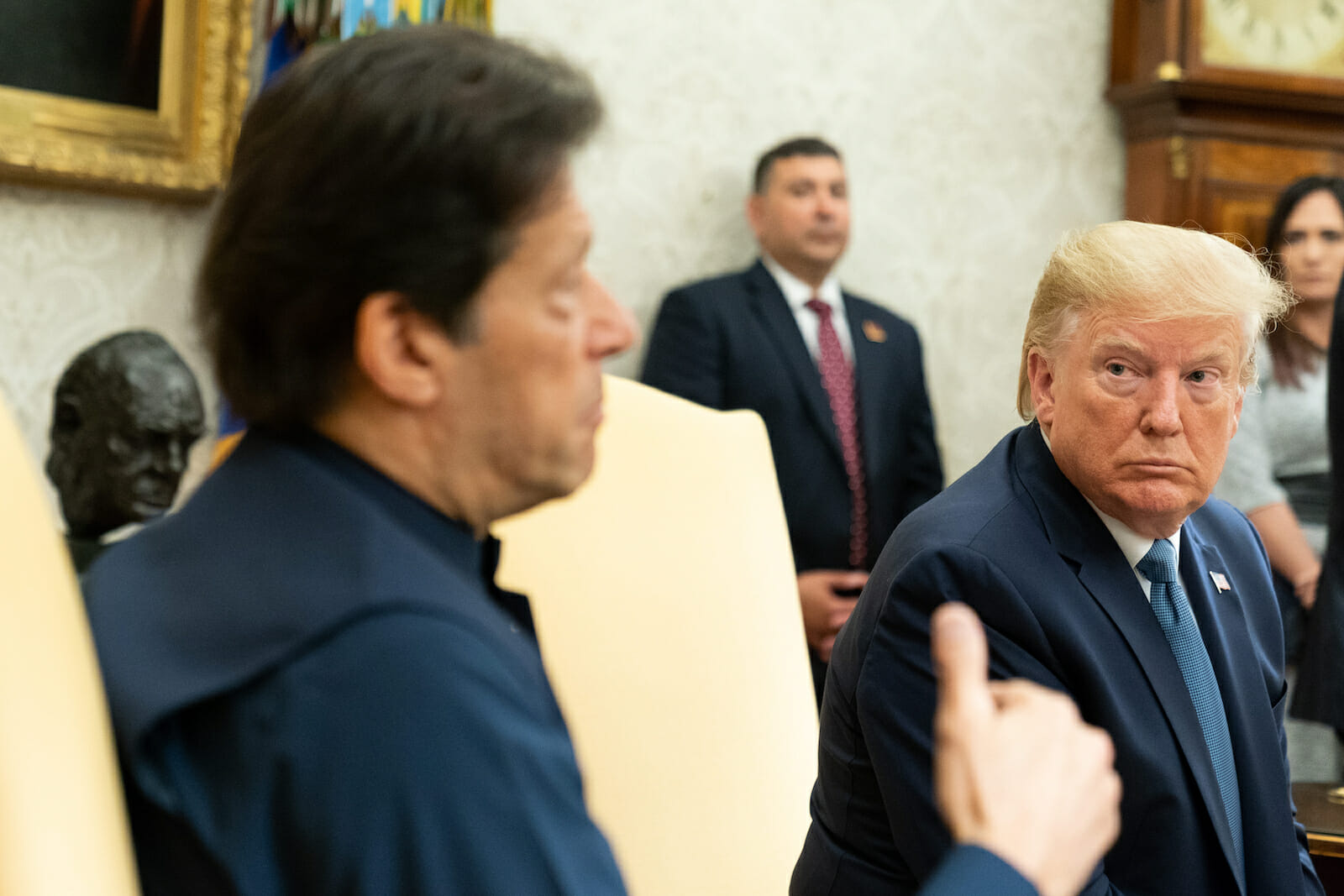
A U.S.-Pakistan ‘Rapprochement’?
Prime Minister Imran Khan of Pakistan visited Washington on a three-day official working visit for talks with President Trump and other top U.S. officials and lawmakers as well as meetings with the U.S. business community to “invite them to benefit from the economic opportunities in Pakistan,” according to a report by Dawn. Top Pakistani officials accompanied the prime minister, including the country’s powerful Army Chief of Staff General Qamar Bajwa, who also met with top U.S. defense officials in the Pentagon.
The main discussions on both the political and military levels were to improve bilateral ties, as the U.S. is engaged in talks with the Taliban in order to withdraw from its longest war, but has not succeeded yet in meeting its objectives in Afghanistan, although the U.S. negotiator Zalmay Khalilzed has recently declared that a “lot of progress” has been accomplished in the latest round of talks in Doha. The two countries have been working to collaborate on ending the war in Afghanistan on the diplomatic level, and Washington has recently recognized the progress on Afghan reconciliation that Pakistan has made. As a sign of a new rapprochement, the U.S. has designated the Balochistan Liberation Army (BLA) as a terrorist group, while Pakistan has again arrested the leader of the Lashkar-e-Taiba, who was responsible for the deadly Mumbai attacks in November of 2008, although it is still dubious whether that arrest will be irreversible or not.
Two main issues have pressed both Washington and Islamabad to seriously mend their ties: the Taliban talks, where a lack of Pakistan’s cooperation would seriously hinder any prospect of a U.S.-Taliban agreement and Pakistan’s economic crisis, where it has recently secured a bailout from the IMF and other countries in the Persian Gulf (most notably Saudi Arabia and the UAE), but also Islamabad would be interesting to receive investments from U.S. businesses, although it would depend on a stable U.S.-Pakistan political relationship.
U.S.-Pakistan relations post 9/11: A history
Pakistan, a key partner of the U.S. during the days of the Cold War had a complicated relationship with the U.S. since the end of the Cold War, especially since the U.S. intervened in Afghanistan in 2001. Although in the early days of the War on Terror, both countries took steps to improve their bilateral ties in both the security and defense domains, including lifting U.S. sanctions against Pakistan that were imposed after it joined the nuclear club, as well as designating Islamabad as a “non-NATO ally,” the two countries have failed to improve their cooperation on the war in Afghanistan and mutual mistrust shaped their partnership.
The U.S. expressed concerns regarding terrorist elements that were either provided sanctuary in Pakistan or being tipped off by elements of the Pakistani security establishment, thus accusing Islamabad of playing a “double game.” Pakistan was also not happy with the U.S. drone strikes in its territory that were designed to hunt down radical groups and the lack of information-sharing regarding the strikes. The U.S. did not inform the Pakistanis ahead of those drone strikes, because of its concern that there are elements in the Pakistani security apparatus that have ties to extremist groups in both Afghanistan and Pakistan. After all, the U.S. troops did kill the leader of Al-Qaeda, Osama bin Laden, not in Afghanistan, but in Pakistan in 2011, in a compound in Abbottabad that is nearby a Pakistani military academy.
Cooperation continued, while the security interests of both countries diverged. For America, the war on terror was a top priority, but for Pakistan, keeping an eye on its neighbour and strategic adversary, India was always the most immediate threat to its national security. In a situation, where the two sides threat assessments have diverged, the two continued to cooperate, while at the same time having concerns about the other’s intention. According to a report from The Atlantic, Pakistani officials were also very concerned about America’s intentions to denuclearize Pakistan after the Abbottabad raid in 2011. Pakistan decided to disperse both its nuclear weapons and missiles, so as to complicate any U.S. decision to neutralize Pakistan’s nuclear program. The U.S. was also concerned about the safety of Pakistan’s nuclear arsenal, and the likelihood of those weapons being in the wrong hands (i.e. a rogue general, a coup where radicals take over the country, etc) as the country’s civil-military relations are uneasy to say the least, and the government’s stability is highly threatened by fundamentalist.
While those concerns existed behind closed doors, and officials from both countries had sometimes traded accusations against one another, Pakistan was interested in relying on U.S. military and humanitarian aid, as well as its military technology, while Washington had reached a consensus that in order to defeat Islamist groups in Afghanistan and Pakistan, Islamabad’s cooperation is crucial. John Bolton, the current U.S. National Security Advisor once called Pakistan the place where either “the U.S. will win or lose Afghanistan.” But things changed at least on the surface when Donald Trump came into office.
Today’s U.S.-Pakistan relations. In Donald Trump’s South Asia strategy, ending the war in Afghanistan was everything, and supporting the Taliban or other radical groups in the region was a red line that if one crosses, consequence will lie ahead. In a major address to the nation on August 2017, by announcing his new strategy in South Asia, Trump accused Pakistan of providing “safe haven to agents of chaos, violence, and terror” – a classic concern that both the Bush and Obama administrations have expressed in different ways. But, Trump did follow up this concern by taking action and leveraging America’s military aid to Pakistan, for Islamabad’s cooperation on Afghanistan (although it wasn’t the first time that aid was cut). But negotiations with the Taliban resumed, and thus cooperation with Pakistan and also with other players in the region became critical, and this opened a window for new talks between the U.S. and Pakistan on both the diplomatic, political and military levels.
But concerns are still there and new ones may come up along the road. Under Trump’s South Asia strategy, the U.S. invited India to expand its involvement in Afghanistan through both economic and development aid, and although it has not officially requested it, the Trump administration would like to see India playing an active security role by sending some of its troops to Afghanistan. This is a red line for Islamabad, as it is concerned that India may expand its influence in Afghan political circles and may build a government that threatens Pakistan’s interests. After all, in the minds of Pakistani policymakers and strategic thinkers, Afghanistan serves as a strategic buffer for Pakistan to limit the threats it considers are posed to its security by India. So a U.S. invitation for India to increase its presence in Afghanistan is a non-starter for Islamabad.
Aside from Afghanistan, where relations between the two countries are not perfect, the geostrategic environment in South Asia is changing, and for that, the U.S. and Pakistan may find themselves at odds with each other in some areas, while cooperating in others. As a source of both economic cooperation, and a leveraging point against the U.S., Pakistan has developed a close partnership with China, and received critical investments in both the energy and infrastructure areas from Beijing as part of the China-Pakistan Economic Corridor The two countries need to have some pragmatic understanding on how to address the security threats that are posed by Pakistan through proxies to India, in order to avoid a new Pulwama type situation that could escalate to a conventional standoff between two nuclear-armed states.
If the U.S. and Taliban negotiations with Pakistani support make progress on setting up a time table or conditions for U.S. troops to withdraw from Afghanistan, then the U.S. and Pakistan will have an opportunity to improve relations. In the words of Shamila Chaundry, a former top official in the U.S. State Department, the U.S. attempt to withdraw from Afghanistan through a negotiated settlement with the Taliban provides an opportunity for Pakistan “to earn a chance to rebuild a new and enduring relationship with the U.S.” if it succeeds in keeping pressure on the Taliban to not leave the negotiating table. The U.S. request will not be only focused on cooperation in Afghanistan, it may also include reducing the threats that are posed to India that are originated from Pakistan through proxies, an area where Imran Khan’s cooperation is limited, and the green-light of the military-intelligence apparatus is much needed, which makes the participation of the top officials in those services critical. Especially at a time when the self-declared deal maker, Donald Trump, has centered himself yesterday to broker a deal between India and Pakistan on the question of Kashmir – although it is dubious as to the ability of the U.S. to mediate the two neighbours and archrivals.
In general, while Pakistan will play a role in the U.S.-Taliban talks and may press the Taliban for the time being, and may also take a hard line against its home-based terrorist groups like Lashkar-e-Taiba, it is difficult to envision a situation where the U.S. and Pakistan interests will be closely aligned, especially on the question of Afghanistan. The U.S. president is committed to removing U.S. forces from Afghanistan, although a timetable has not been set. Will Pakistan be happy with a U.S. withdrawal from its neighbour, especially at a time the region’s balance of power and what may follow a U.S. withdrawal is not clear? These and other structural questions will limit the areas that the two countries see eye-to-eye on, and for that reason, one should be skeptical about a real rapprochement between the U.S. and Pakistan in coming years, although diplomacy is always welcome.

